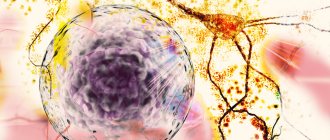Involutional paranoid (senile paranoia) is a mental illness that develops at the age of 45–60 years or older. The main manifestation of involutional paranoid is everyday delusions or delusions of “small scope.”
A psychiatrist is involved in the diagnosis and treatment of involutional paranoid.
Delusion is called everyday because it involves everyday (ordinary, ordinary) situations and people from the immediate environment: relatives, friends, work colleagues.
The disease develops gradually. At first, a person begins to more keenly notice suspicious (in his opinion) signs: phrases, actions. Then close people become in his eyes the source of all possible troubles - they “spoil” his property, “deteriorate” his health. A person tries by any means to protect himself from these “pests”. It is impossible to dissuade him; he finds more and more evidence of atrocities.
In men, senile paranoia sometimes takes on the character of jealous delirium. A man finds more and more signs that indicate his partner is unfaithful. It is impossible to convince him, even if you are nearby around the clock. A person with a disorder interprets ordinary things in a delusional way - if a woman is talking on the phone or straightening her clothes or hair, he sees “signs” in everything, evidence that she has someone else.
Important
It is impossible to dissuade a person - the disease speaks in him. A sick, exhausted psyche “turns all logical and sober arguments inside out.” It is better to calmly agree with the person and quickly take him to a competent doctor.
Sometimes involutional paranoid is accompanied by hallucinations: auditory, olfactory, tactile. Hallucinations always clearly correspond to the theme of delirium: if a person believes that the neighbors are to blame for everything, then all the visions will be associated precisely with the “interventions” of the neighbors.
Without treatment, the symptoms of involutional paranoid increase, and the mental state worsens. Psychiatrists successfully treat the disorder; it does not threaten the person with dementia. But you need to seek help before a person causes harm to himself or loved ones.
How to diagnose involutional paranoia?
Although the symptoms of senile paranoia are of an everyday, “small-scale” nature, diagnosing involutional paranoid is not difficult for an experienced psychiatrist. In addition to obvious and hidden symptoms, the doctor can help confirm the diagnosis:
- Clinical and anamnestic study - a detailed conversation with a person and his relatives. It is important for the doctor how the disease began, what the first “oddities” were, how it developed, when it worsened. Mental illness in close relatives supports the diagnosis.
- Pathopsychological research - a clinical psychologist uses special tests to analyze disorders of thinking, attention and memory. The psychiatrist takes his conclusion into account when making a diagnosis.
- Modern instrumental methods - Neurotest and Neurophysiological test system - record deviations in blood tests and physiological indicators, which can confirm the diagnosis of an endogenous disorder and show its severity. These are one of the few accurate (individual-independent) tests for mental disorder.
At the first appointment, an experienced doctor notes the symptoms of senile paranoia and the patient’s unnatural reaction. It is especially inadequate when answering questions that concern the immediate environment.
Involutional paranoid must be distinguished from other mental illnesses. What distinguishes involutional paranoid from late-onset schizophrenia is the absence of dementia; the person is well oriented in the world around him and can more or less take care of himself. It differs from organic brain damage in the absence of clear neurological symptoms.
EEG, CT, MRI and routine blood tests do not show specific changes in patients with involutional paranoid (unless the disorder occurs along with another lesion of the body or brain).
Presenile psychoses
Involutionary melancholy
The disease begins gradually, the duration of the initial period is usually 2-3 months, sometimes up to 1 year or more.
With intense exposure to unfavorable factors (exacerbation of therapeutic pathology, severe stress), the duration of the initial stage can be reduced to several weeks. In the initial period, lethargy, weakness, increased fatigue, and mood disorders prevail. When the first symptoms appear during menopause, an increase in autonomic disorders is noted. Patients usually explain the change in psychological state by overwork, some external circumstances, and suspicions may arise about the presence of a serious somatic illness. With the progression of presenile psychosis, the main place in the clinical picture is occupied by depressive and anxiety symptoms. Pointless anxiety, filled with unjustified gloomy forebodings, intensifying in the evening, increasing with any changes in the usual routine. Melancholy is present, but is not the leading manifestation of the disease. Previously, motor and speech restlessness, turning into agitation, was considered a characteristic sign of involutional melancholia, but modern psychiatrists point out that nowadays the disease increasingly occurs not with agitation, but with lethargy, apathy and lethargy. Suicidal thoughts and intentions are often observed.
At the height of the illness, some patients develop overvalued, obsessive, delusional and paranoid ideas. Delirium is often based not on current events, but on traumatic situations that have ended long ago. Possible delusions of persecution, damage or unfair accusations by others, hypochondriacal delusions. In some cases, illusions and hallucinations are noted. In severe cases, patients in the older age group sometimes develop Cotard's delirium, in which patients claim that they lack internal organs, that they have painful immortality or evil power (for example, they poison the entire Earth with their miasma), etc.
Involutional melancholia is characterized by a single, protracted attack. With timely and adequate therapy, psychotic phenomena in some patients are reduced, and over time a stable remission occurs. In other cases, chronicity is observed with monotony of clinical manifestations, practically unchanged for several years. Subsequently, mental disorders gradually become less pronounced, and a mental defect is formed in the form of a persistent decrease in mood, rigidity, and a tendency to worry about unimportant reasons.
Involutionary paranoid
As in the previous case, presenile psychosis develops gradually. Pathology more often occurs in individuals with corresponding premorbid personality characteristics (rigidity, stubbornness, conservatism, suspicion) against the background of unfavorable life circumstances. The appearance of delusional ideas is often preceded by increased sensitivity and suspicion regarding everyday events. Against this background, ideas of interpretation and relationship emerge, and later ideas of persecution. At first, delusional ideas are local in nature, have an everyday coloring that does not go beyond the usual ideas about possible conflicts with other people, are not accompanied by changes in worldview and behavior, and therefore do not cause the wariness of others.
Subsequently, patients' complaints become more and more divorced from reality, falling outside the framework of usual ideas. The most common delusion is damage. Patients may claim that members of their inner circle secretly enter their home, add poison to food or drink, and steal and damage low-value items. Sometimes there is delusion of jealousy, rarely - hypochondriacal delusion. Patients show extreme persistence in trying to protect their rights, often do not limit themselves to requests to stop the “sabotage”, violently express their feelings, turn to official authorities (police, court, administration) and even try to deal with the “offenders” on their own. Delusions may be accompanied by hallucinations and illusions. Patients hear voices or noises behind the wall, feel the unpleasant taste of “poisoned” food, etc.
Presenile psychosis usually occurs chronically. In many patients, delusional ideas persist for many years, sometimes until the end of life. Less commonly, the intensity of delusional ideas decreases over time, sometimes delusional ideas practically disappear. Residual phenomena persist in the form of inertia of mental processes, excessive suspicion, increased vigilance, periodic fears about possible harmful actions on the part of loved ones, neighbors or acquaintances.
APPLICATION
CONTENTS Take the Szondi test ONLINE Key to the Szondi test Stimulus material
| Back | Forward > > |
Interpretation of some definitions of the Szondi
Avel tendencies
(Abel is a biblical character who was innocently killed by his brother Cain) - an expression of goodwill, emphasized meekness, morality, moral purity, selflessness.
Agitated activity
— — disordered activity against a background of elevated mood, hypomania.
Allodestruction
— experiencing the destruction of the picture of the surrounding world with a violation of the primary trust in people.
Ambitiousness
- duality and inconsistency of motivation.
Anal-masochistic tendencies
- a combination of anal-erotic traits with anancastic ones (passivity, dependence, increased sense of guilt).
Anal-erotic type
- a personality type characterized by the deification of the object of love affection, which makes it difficult to realize sexual desire; competitive attitude towards the father, jealousy and tenderness towards the mother, transferred to the object of love affection; the desire to hoard, pedantry, stubbornness as character traits.
Autism
- isolation, focus on the world of one’s own ideas and fantasies, isolation from others.
Autodestruction
— destruction of one’s own “I”, including through alcohol or drugs.
Affective release
- 1) apathetic state after an attack (paroxysm) or storm of anger, rage, hatred; 2) calm after a migraine, epileptic seizure, neurotic, allergic or psychosomatic disorder; 3) relaxation after making a difficult decision.
"Affective flood"
- emotional exaltation, agitation, unjustified enthusiasm, an abundance of emotions associated with emphasized conscientiousness and a heightened sense of justice.
Affective entrainment
- emotional tension poorly controlled by reason, colored by subjectivity and bias.
Secondary masochism
- exacerbation of sexual sensations from both physical and moral pain emanating from the object of affection.
Hypomania
— unmotivated increased mood background.
Destructive need
- the need for destructive aggressive discharge.
Disintegration of the Self
- disturbed intrapersonal harmony, weakened self-control, inadequate self-esteem.
Dominant ethical principle in the absence of a brake
- open manifestation of subtle emotional experiences associated with love and tenderness.
Dominance
— predominance.
Dualunion
- painful attachment to mother or father with mutual aggression, leaving an imprint on the lifestyle.
The rigidity of the male major “I”
- a vivid manifestation of masculinity, manliness.
Inversion
- deviations in normal sexual desire, which involves being directed towards people of the opposite sex.
Incestuous love
- sexual relations with a close relative.
Cain's tendencies
(Cain is a biblical character who killed his brother) - an expression of rigidity, selfishness, cynicism, disregard for moral principles
Catatonic manifestations
- motor stupor or storm, beyond the control of the “I” due to personality disintegration.
Introjection
- inclusion of the entire surrounding world into one’s “I” with inflated self-esteem.
Inflationary paranoid
- a wary and delusional attitude towards the environment as hostile.
Don Juanism complex
- self-affirmation of an insecure person through an exorbitant expansion of contacts that are essentially superficial.
Latent
- hidden.
Libidinal-stagnant personality
- a person with an unfulfilled libidinal need.
Libidinal need
- the intensity of the need for activity, which can manifest itself not only as the need for sex, but also as self-realization of the individual in a broad sense.
Masochistic tendencies
- a tendency to self-harm (with an increased sense of guilt or the ability to experience special pleasure when pain is caused by another person, including a sexual partner at the moment of intimacy.
Manic manifestations
- excessive ideational disinhibition, that is, verbosity, an influx of ideas, a sharply increased emotional background with weakened self-control and inadequately inflated self-esteem.
Melancholic reaction
- reduced mood background.
Mythomania
- lying as a defensive reaction to life’s reality.
Soft, minor "I"
- femininity, femininity.
Moral masochism
- a pronounced tendency to self-sacrifice, an increased sense of guilt, replacement of the libidinal need with professional, social or spiritual employment.
Multilateral communication
— multiplicity of contacts without depth of relationships.
Narcissistic Traits
- self-centered narcissism, focus on one’s “I”.
Unfulfilled homosexuality with narcissistic manifestations
- latent (hidden) or well-controlled (suppressed) attraction to people of the same sex with narcissism and self-centered focus on one’s “I”.
Paranoid phenomena
- delusional judgments based on impaired perception.
Paranoia
- wariness, distrust, readiness to build a delusional concept in the sphere of interpersonal relationships.
Primary form of masochism
- the desire to experience cruelty and pain on the part of a sexual partner at the moment of intimacy.
Pseudology
- pathological deceit.
The problem of insoluble dual union
- painful attachment to one of the family members with painful sadomasochistic relationships that cannot be changed or interrupted.
Discharge after an affective outburst
- a feeling of relaxation after experiencing an emotional storm.
Regressive form of contacting
- a form of communication inherent in the period of early childhood. Infantilism.
Regressive form of interpersonal communication
- immature, infantile, characteristic of a child in early childhood.
Poorly integrated "I"
- an insufficiently strong and harmoniously organized “I”, which can manifest itself as poor self-understanding, unstable self-esteem and reduced self-control.
Sadism
- a cruel form of fulfillment of sexual need, which also manifests itself as destructive tendencies in interpersonal communication.
Sadohumanism
— declared selflessness and humanity while using harsh methods of putting pressure on others.
Sadomasochism
- alternate manifestation of sadistic (cruel) and masochistic (submissive) tendencies, a regressive form of sexuality; sadomasochism, in addition to sexual contacts, can manifest itself along with strong attachment in increased demands on the object of affection and a patient attitude towards his cruelty (“tormented tormentor”).
The weakness of moral censorship
- self-exposure or self-demonstration in the absence or weakness of control of reason over emotions.
The desire for participation
- self-isolation, focus on your inner world.
Sublimation of libidinal need
— translation of unfulfilled sexual need into one or another type of social activity.
Universal dominant
- the predominance of a single drive as dominant.
Phobic experiences
- fears that cannot be controlled and criticized.
Schizoid manifestations
- isolation, subjectivism, wariness, individualism, originality of statements and actions, emotional coldness, egocentrism.
Oedipus complex
- deification of the object of love's affection, making it difficult to realize sexual desire. Competitive attitude towards father, jealousy and tenderness towards mother, transferred to the object of love affection.
Exhibitionism
- self-exposure or self-demonstration.
Epi disorders
- painful manifestations of the type of epilepsy (paroxysmal, paroxysmal nature of the disorder with convulsive phenomena against the background of altered consciousness or outbursts of unmotivated rage against the background of viscous concrete thinking, painfully manifested pedantry and sweetness).
Eros-hypertensive reaction
- excessive, intense need for tenderness (sexual or interpersonal), aimed at a specific person.
Eros-need
- the need for tender (sexual and human) contacts.
Erotomania
- sexual disinhibition.
Eros factor
- a factor of tenderness aimed at a specific person.
S-risk
- the danger of committing suicide, that is, committing suicide.
| Back | Forward > > |
CONTENTS Take the Szondi test ONLINE Key to the Szondi test Stimulus material
INVOLUTIONAL PSYCHOSES
INVOLUTIONAL PSYCHOSES (from Latin involutio – coagulation, fading) (presenile psychoses, presenile insanity), a group of psychoses that arise primarily. at the age of 50–60 years and manifesting hl. arr. anxiety-depressive and delusional disorders, but, as a rule, not leading to dementia. More often observed in women during menopause. Isolation of I. p. in independent. nosological group by E. Kraepelin was associated with the hypothesis about the decisive influence in their origin of the age factor - involution, first formulated by K. Kahlbaum in 1879. Initially they were designated by the term “paraphrenia” (psychoses during puberty were called hebephrenia, and mental disorders during puberty were called presbyophrenia ). As a main forms of I. p. were distinguished by involution. melancholy and involution. paranoid However, subsequent studies showed that I. p. represent syndromes of different mental disorders. diseases, including endogenous, vascular and other somatically caused, which arise in involution. age and acquire clinical similarity due to pathoplastic influence of the body's fading factor. In modern international classifications of mental diseases I. p. as independent. group of diseases are not included.
For involution. melancholy (involution depression) is characterized by deep melancholy with anxiety, excitement, delusions of damage, ruin, self-accusation; high risk of suicide. Patients are in constant psychomotor agitation. During an exacerbation, they lament, moan, rush about, try to injure themselves, and commit suicide. Excitement may be replaced by immobility, numbness (stupor). Gradually, delusional ideas take on more and more fantastic content, reaching melancholic. paraphrenia with megalomaniac delusions of denial internal. organs, own life, the world around us with the paradoxical delirium of our own. eternal torment in eternal immortality (Cotard's syndrome, nihilistic delirium). The course is protracted, long-term with possible remissions or continuous. Clinical picture of involution. paranoid (presenile delusion, involutional paraphrenia) is manifested by delusional tension, suspicion with delusional ideas of damage, poisoning, adultery, which are associated with others - relatives, neighbors. Characterized by active delusional behavior aimed at exposing imaginary persecutors and protecting against them. The course is chronic. With both forms of I. p., the prognosis for recovery is questionable. With the so-called malignancies involution melancholy (Kraepelin's disease) develops motor and speech excitation with stubborn resistance, negativism, refusal of food and medical procedures, rapid onset of physical symptoms. exhaustion and cachexia. If left untreated, death soon occurs.
Treatment for all forms of I. p. is carried out in a psychiatric hospital. hospital, regardless of the patient’s consent in accordance with Art. 29 of the Law of the Russian Federation on mental health. assistance and guarantees of the rights of citizens in its provision.
PREVALENCE
Due to the divergence of views on the diagnosis of involutional psychoses, data on their prevalence in the domestic psychiatric literature (in different forms) fluctuate within very wide limits. So, if V. L. Efimenko (1969, 1975) among depression of late age reveals involutional melancholy in 21.4% of cases, then E. Ya. Sternberg and M. L. Rokhlina (1970) reveal it only in 5.5 % of cases. The situation is approximately the same with the statistical indicators for involutionary delusional psychoses, which B. A. Lebedev finds among delusional psychoses of late age in 30% of cases, and N. F. Shakhmatov - in only 1.8% of all patients over 65 years of age, admitted to the Moscow psychiatric hospital named after. P. B. Gannushkina for the decade from 1954 to 1963. However, this does not reduce the great importance of this contingent of patients in psychiatric practice.
If you find an error, please select a piece of text and press Ctrl+Enter.










